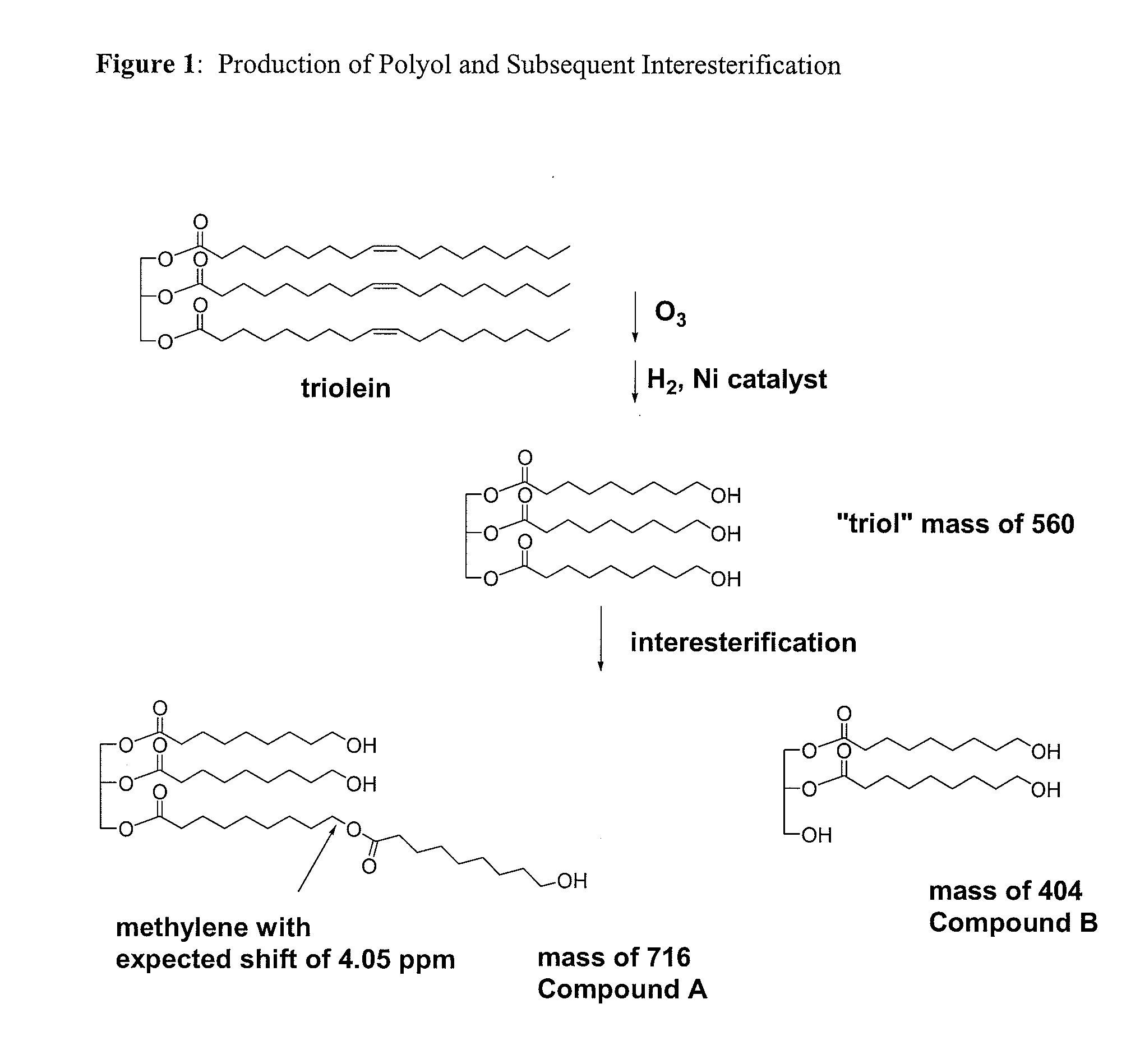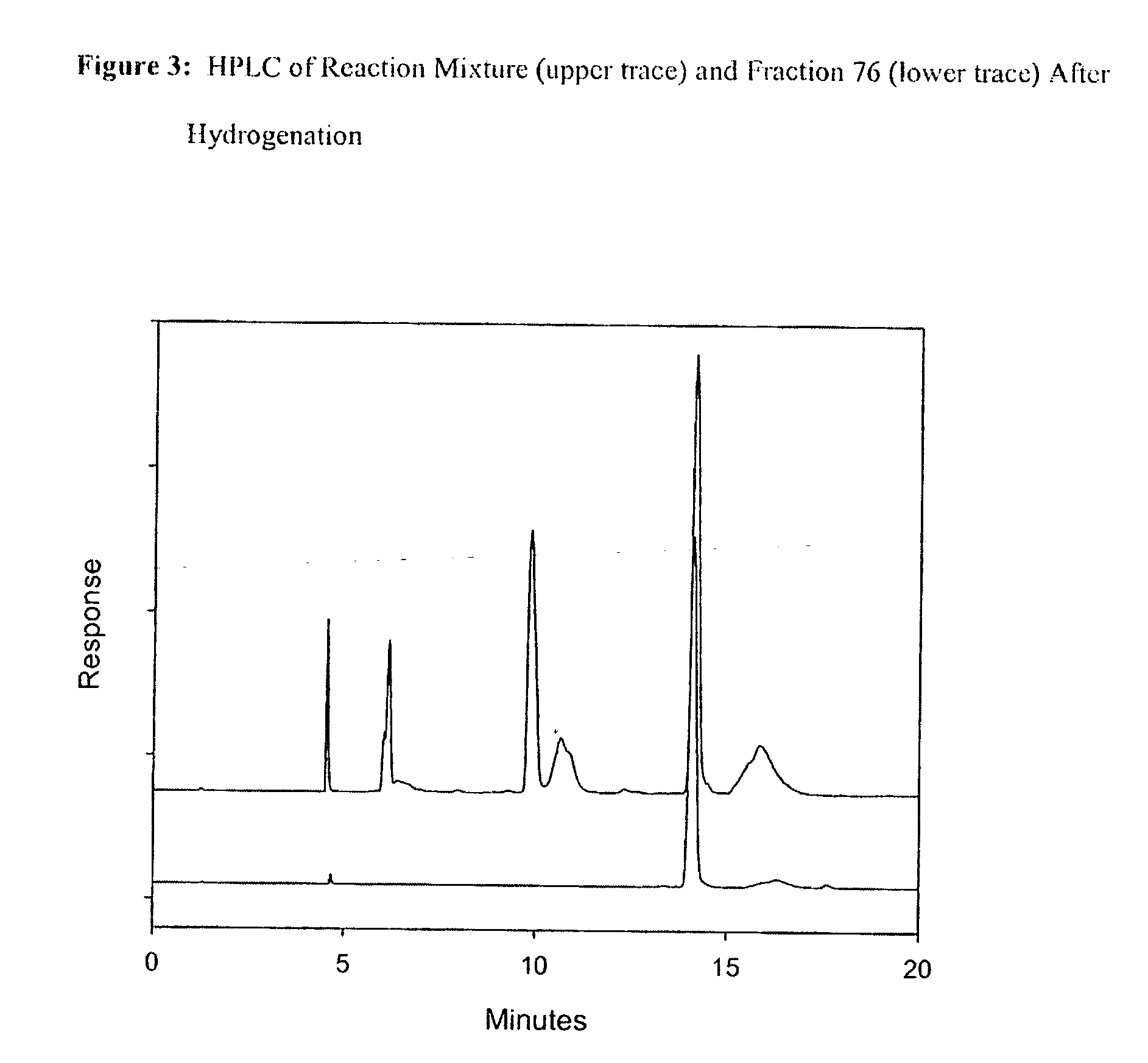Bioplastics, monomers thereof, and processes for the preparation thereof from agricultural feedstocks
- Summary
- Abstract
- Description
- Claims
- Application Information
AI Technical Summary
Benefits of technology
Problems solved by technology
Method used
Image
Examples
example 1
Preparation of Polyols from Triolein (GI-Polyol)
Step A—Ozonolysis
[0330] Triolein (15 g) was dissolved in 150 mL of pentane and brought to −10° C. in a 500 mL three-necked flask using an external 50:50 mixture of glycol water from a Jeiotech VTRC-620 temperature bath from Rose Scientific. Ozone was produced in an Azcozon ozone generator Model number RMV16-16 from Azco Industries Ltd. In an attempt to minimize acid production the ozone treatments (10 min of air flow) were alternated with a nitrogen purge (5 min) at a gas flow rate of 5 L / min. These alternate gas flows were carried out seven times with the final nitrogen purge taking 20 min. The total ozonolysis time was therefore 70 min and the total nitrogen purging 50 min. During the gas flow pentane evaporated so it became necessary to continually top up the solvent level. In total, an additional 350 mL of pentane was required over the entire ozonolysis. The additional pentane was all added prior to the final nitrogen purge when...
example 2
Preparation of Polyols from Canola Oil (GII-Polyol)
Ozonolysis Reactor
[0339] The reactor 10 presently disclosed offers an improvement over prior art ozonolysis vessels, such as those utilized by Lin, S. H. and Wang, C. H. (Industrial wastewater treatment in a new gas-induced ozone reactor, Journal of Hazardous Materials,98 295-309,(2003)) illustrated in FIG. 41 (Prior Art). The reactor of the present invention is fed with a motor 28, such as a Direct Current Permanent Magnet 1 HP Motor from Leeson electric-corporation, USA. The water, which temperature is controlled by a chiller, is rushed into the outer layer 14 of the reactor (entry labelled “H2O in”; 16), circulated around the reaction vessel 12 and evacuated (labelled “H2O out”; 18). The water is kept flowing during the reaction to keep the reaction system at a constant temperature. Ozone is generated in an ozone generator (such as Azcozon Model RMV16-16 from Azco Industries Ltd, Canada) with oxygen or air as the feed gas, and...
example 3
Preparation of Polyols from Canola Oil and Flax Oil
[0352] Three grades of polyols were synthesized in this example: (i) polyols from canola oil using oxygen gas supply to generate the ozone, and referred to as canola-oxygen; (ii) polyols from canola oil using air supply to generate the ozone, and referred to as canola-air; and (iii) polyols from flax oil using air supply to generate the ozone, and referred to as flax-air.
Step A—Ozonolysis
[0353] The preparation of polyols from canola and flax was generally conducted as set out in the previous examples above. Briefly, the polyols were synthesized by ozonolysis of the vegetable oils followed by hydrogenation in the presence of a nickel catalyst. The ozonolysis was carried out in a reactor fed with ozone gas generated by a Model-RMU 16-16 generator from Azco Industries Ltd supplied either with air or oxygen. The hydrogenation was completed in a Parr-Pressure Reaction Apparatus (Parr Instrument Company Inc). The vessel temperature of...
PUM
| Property | Measurement | Unit |
|---|---|---|
| Temperature | aaaaa | aaaaa |
| Fraction | aaaaa | aaaaa |
| Angle | aaaaa | aaaaa |
Abstract
Description
Claims
Application Information
 Login to View More
Login to View More - R&D
- Intellectual Property
- Life Sciences
- Materials
- Tech Scout
- Unparalleled Data Quality
- Higher Quality Content
- 60% Fewer Hallucinations
Browse by: Latest US Patents, China's latest patents, Technical Efficacy Thesaurus, Application Domain, Technology Topic, Popular Technical Reports.
© 2025 PatSnap. All rights reserved.Legal|Privacy policy|Modern Slavery Act Transparency Statement|Sitemap|About US| Contact US: help@patsnap.com



